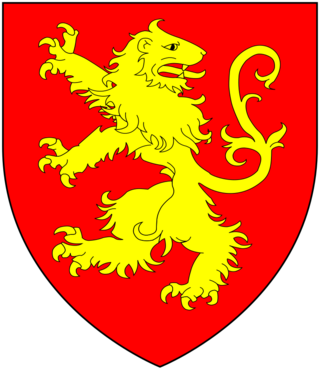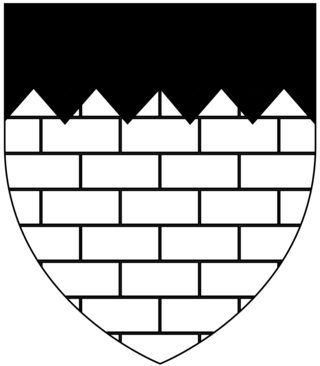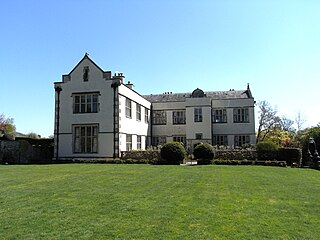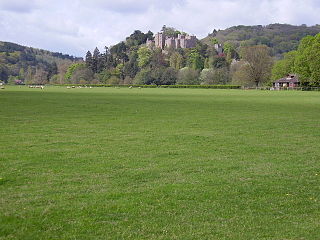
Sir William Courtenay, 1st Baronet (7 September 1628 – 1 August 1702) was an English politician.

Sir William Courtenay, 1st Baronet (7 September 1628 – 1 August 1702) was an English politician.
Courtenay was the eldest son and heir of Francis Courtenay (d. 1638) of Powderham Castle by his second wife Elizabeth Seymour, daughter of Sir Edward Seymour, 2nd Baronet.

He was created a baronet in 1644 by King Charles I but disdained the newly invented variety of title, perhaps on political grounds, and never took out a patent. He was therefore not included in the list of baronets, although the king styled his as such in his commissions. [1]
On 2 April 1660, Courtenay became the Member of Parliament (MP) for Ashburton, Devon. [2] However, he retired from politics after the Restoration and appears not to have been returned in 1661. In 1664 he served as High Sheriff of Devon. [2] In 1677 Courtenay's health prevented him from standing for Ashburton but he managed the campaign of the country party. The country party's candidate was unsuccessful, but the government supporters admitted that in a clean election Courtenay's campaign had been very moderate. Notwithstanding that, he had made a new freeholder and "drank him so freely" that he fell downstairs and broke his neck. [2] On 18 February 1679, Courtenay became MP for Devon until 1685. His health prevented him from standing in 1688. [2]
After the Glorious Revolution of 1688, Courtenay funded a lavish reception at Forde House, Wolborough, for William of Orange and his council, who had just landed nearby at Torbay. He was not himself present as host, having felt it prudent not to associate himself too strongly with the new regime should it fail. The chair on which the future King William III sat during his first Council of State at Forde is now displayed in the Dining Hall of Powderham Castle. [3]
Courtenay married Margaret Waller (d. 1694), daughter of Sir William Waller, a parliamentary general in the Civil War, and eventual heiress of her maternal grandfather Sir Richard Reynell (d. 1633) of Forde, Wolborough, Devon, where he had built a new mansion in about 1610. Forde became the couple's main home, possibly due to the damage suffered by Powderham Castle during the Civil War, it having been captured on 25 January 1646 from the Royalist garrison by the parliamentarian forces under Col. Robert Hammond. Certainly, Sir William and his wife were buried at Wolborough and several of their children were baptised there. [4] They had eight children: [5]
Courtenay died aged 73 and was buried at Wolborough, the parish church of Forde House. [4]
He was succeeded by his grandson Sir William Courtenay, 2nd Baronet (1675–1735) de jure 6th Earl of Devon.

Earl of Devon was created several times in the English peerage, and was possessed first by the de Redvers family, and later by the Courtenay family. It is not to be confused with the title of Earl of Devonshire, held, together with the title Duke of Devonshire, by the Cavendish family of Chatsworth House, Derbyshire, although the letters patent for the creation of the latter peerages used the same Latin words, Comes Devon(iae). It was a re-invention, if not an actual continuation, of the pre-Conquest office of Ealdorman of Devon.

Sir William Morice, 1st Baronet, of Werrington, was an English Member of Parliament.
William Courtenay, 1st Viscount Courtenay, also de jure 7th Earl of Devon, was a British peer. He was the son of William Courtenay, 6th Earl of Devon and 2nd Baronet Courtenay, and Lady Anne Bertie.

Richard Reynell (1519–1585) of East Ogwell, Devon, was an English Member of Parliament. An account of him and his sons is given by John Prince in his Worthies of Devon.

Sir Richard Reynell (c.1558–1633) of Forde in the parish of Wolborough, Devon, was an English lawyer and Member of Parliament. He built the surviving Ford House, now in the suburbs of Newton Abbot and his daughter and sole heiress Jane Reynell, married the Parliamentary general Sir William Waller.

Heneage Finch, 2nd Earl of Aylesford (1683–1757) was a British peer and member of the House of Lords, styled Lord Guernsey from 1714 to 1719.

Sir Philip Courtenay of Powderham, Devon, was the senior member of a junior branch of the powerful Courtenay family, Earls of Devon.

Sir William Courtenay, 2nd Baronet of Powderham Castle, Powderham, Devon, was an English landowner, a leading member of the Devonshire gentry and Tory politician who sat in the English House of Commons from 1701 to 1707 and in the British House of Commons almost continually from 1707 to 1735.

Francis Courtenay, de jure 4th Earl of Devon, of Powderham, Devon, was an English Member of Parliament. In 1831 he was recognised retrospectively as having been de jure 4th Earl of Devon, having succeeded his father in 1630.

Sir William Courtenay of Powderham in Devon was a prominent member of the Devonshire gentry. He was Sheriff of Devon in 1579–80 and received the rare honour of having been three times elected MP for the prestigious county seat (Devon) in 1584, 1589 and 1601.

Thomas Reynell of East Ogwell, Devon, was an English lawyer and politician who sat in the House of Commons at various times between 1654 and 1689.

Sir William Courtenay"The Great", of Powderham in Devon, was a leading member of the Devon gentry and a courtier of King Henry VIII having been from September 1512 one of the king's Esquires of the Body. He served as Sheriff of Devon three times: from February to November 1522, 1525/26, and 1533/34. He was elected Knight of the Shire for Devon in 1529.

Forde House, now also known as Old Forde House, is a Grade I listed Jacobean former manor house in Newton Abbot, Devon, England. It was built in c. 1610 and is noted for its fine 17th-century wood-carving and plasterwork. Once the manor house of the parish of Wolborough, it is now absorbed into a suburb of Newton Abbot. The south front is clearly visible from the busy Brunel Road which cuts across the house's front lawn.

Sir Edmund Prideaux, 1st Baronet (1554–1628), of Netherton in the parish of Farway, Devon, was a Councellor at Law and Double Reader of the Inner Temple and was created a baronet on 17 July 1622. He purchased the estate of Netherton where in 1607 he built a new mansion house, known today as Netherton Hall, a grade II listed building. He was one of John Prince's Worthies of Devon.

The Devon and Exeter Institution is a subscription library in the City of Exeter, Devon, founded in 1813 for "The general diffusion of science, literature and the arts". It is situated at 7, Cathedral Close, Exeter, in a building facing the north side of Exeter Cathedral which was formerly the Exeter townhouse of the Courtenay family of Powderham Castle.

Great Fulford is an historic estate in the parish of Dunsford, Devon. The grade I listed manor house, known as Great Fulford House, is about 9 miles west of Exeter. Its site was said in 1810 to be "probably the most ancient in the county". The present mansion house is Tudor with refurbishment from the late 17th century and further remodelling from about 1800. The prefix "Great" dates from the late 17th century and served to distinguish it from the mansion house known as "Little Fulford" in the parish of Shobrooke, Devon, about 8 miles to the north-east, also owned briefly by Col. Francis Fulford (1666–1700), as a result of his marriage to the heiress of the Tuckfield family. Great Fulford has been the residence of the Fulford family, which took its name from the estate, from the reign of King Richard I (1189–1199) to the present day. There are thus few, if any, families in Devonshire of more ancient recorded origin still resident at their original seat. In 2004 the estate comprised 3,000 acres.

Netherton in the parish of Farway in Devon is an historic estate situated about 3 1/2 miles south-east of Honiton. The present mansion house known as Netherton Hall was built in 1607 in the Jacobean style, restored and rebuilt 1836-44, and is a Grade II listed building.

The feudal barony of Dunster was an English feudal barony with its caput at Dunster Castle in Somerset. During the reign of King Henry I (1100–1135) the barony comprised forty knight's fees and was later enlarged. In about 1150 the manors retained in demesne were Dunster, Minehead, Cutcombe, Kilton and Carhampton in Somerset, and Ham in Dorset.
Sandridge is an historic estate in the parish of Stoke Gabriel in Devon, situated on high ground at the head of the River Dart estuary. The estate was originally encompassed on three sides by the river, which meanders along its border, leaving it on the east side. The present grade II* listed Italianate style Regency mansion house known as Sandridge House was built in 1805 by Lady Ashburton, to the design of John Nash.

Painsford is an historic estate in the parish of Ashprington in Devon.